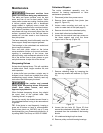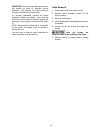
21
Taper Cuts
A useful jointer operation is cutting an edge to a
taper. The method can be used on a wide
variety of work. Tapered legs of furniture are a
common example. Instead of laying the piece on
the infeed table, lower the forward end of the
work onto the outfeed table. Do this very
carefully, as the piece will span the knives, and
they will take a "bite" from the work with a
tendency to kick back unless the piece is firmly
held. Now push the work forward as in ordinary
jointing.
The effect is to plane off all the stock in front of
the knives to increasing depth, leaving a tapered
surface. The ridge left by the knives when
starting the taper may be removed by taking a
very light cut according to the regular method for
jointing, with the infeed table raised to its usual
position.
Practice is required in taper operations, and the
beginner is advised to make trial cuts on waste
material. Taper cuts over part of the length and
a number of other special operations can easily
be done as the operator gains experience.
Rabbeting
A rabbet cut requires
removal of the cutter guard. Use extreme
caution and keep hands clear of cutterhead.
Always replace guard immediately after
rabbeting operation is completed.
A rabbet is a groove cut along the edge of a
board. The width and thickness of the wood to
be rabbeted depends upon the width and length
of the rabbet. However, never rabbet a piece of
wood less than 12" long. Use push blocks to
rabbet cut whenever possible.
4. Disconnect machine from power source.
5. Set fence for the desired width of the rabbet.
6. Check the width of the rabbet by measuring
the distance from the end of a knife in the
cutterhead to the fence.
7. Lower infeed table 1/32" at a time and make
successive cuts until the desired depth of
rabbet has been obtained. See Figure 33.
NOTE: It is easier and safer to take a series
of shallow cuts.
When rabbeting long pieces, follow the same
procedure as for surfacing long pieces (page
19).
Figure 33


















